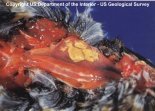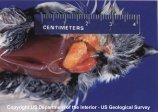|
|
| |
| Causative Agent |
-
A disease caused by infection with Salmonella spp.
bacteria.
-
Relatively small numbers of
bacteria are sufficient to cause
disease.
|
| Images |
|
Click on
images to enlarge. |
 |
 |
|
Lesions of salmonellosis may
appear in large flat areas of the esophagus, as demonstrated in
this evening grosbeak. |
Lesions of salmonellosis in
the esophagus may also appear as large nodules resembling
"cheese", as observed in this house sparrow. |
|
| Distribution |
|
Geographic: |
|
|
|
Seasonality: |
-
Generally, throughout the year.
-
In
passerine birds, salmonellosis
outbreaks are more common at bird feeders during the late
winter and early spring, and also during hot periods in the
summer when birds are stressed and must congregate for food
and water.
-
In colonial nesting
waterbirds, such as gulls, terns and cormorants, outbreaks
of salmonellosis are more common early in the summer when
young-of-the-year are present.
|
|
| Hosts, Transmission and Life
Cycle |
| Hosts: |
-
Humans, wild and domestic mammals, birds, reptiles and insects.
-
Most frequently isolated from birds.
-
Among birds, salmonellosis outbreaks are most frequently reported in
association with
passerine birds at feeders and
colonial nesting waterbirds.
|
|
Transmission and Life Cycle: |
-
Mammals:
-
Infections are acquired from eating feed contaminated
with feces that contain
bacteria shed by carrier animals.
-
Animals can be either
healthy, long-term carriers of the
bacteria and show no clinical signs,
or susceptible to the disease.
-
Salmonella
bacteria primarily invade the wall
of the intestines, causing
inflammation and damage.
-
Infection can spread in the
body through the bloodstream to other organs, such as
the liver, spleen, lung, joints, placenta or fetus, and
the membranes surrounding the brain.
-
Toxic substances produced by
bacteria can be released and affect
the rest of the body.
-
Infected animals may shed
Salmonella
bacteria in their feces for weeks or
months.
-
Salmonella
bacteria are tolerant of a
wide-range of temperatures and survive for months in
soil and water.
-
Birds:
-
Like mammals, infected birds
may shed Salmonella
bacteria in their feces for weeks or
months.
-
Crowding, stress,
contamination of feed with feces, prolonged stays, and
the presence of carriers of Salmonella
bacteria promote the regular
occurrence of salmonellosis at bird feeders.
|
|
| Signs and Symptoms |
-
Mammals:
-
The extent and severity of lesions will depend on the
species, age and health status of the host, as well as the type
of Salmonella.
-
Generally, the intestines appear bloody and
inflamed.
-
Other signs caused by Salmonella infection include:
enlargement of the spleen and
lymph nodes, accumulation of fluid and blood in organs such as the
lungs, and damage to the liver.
-
Birds:
-
As with mammals, the extent and
severity of
lesions
will depend on the species, age and health status of the host as
well as the type of Salmonella.
-
Young birds are more severely affected than older birds.
-
Infected birds may suddenly die or gradually show signs of
disease.
-
Sick
birds are depressed and may huddle together with ruffled
feathers and show unsteadiness, shivering, loss of appetite,
increased or decreased thirst, rapid loss of weight, accelerated
breathing, watery yellow, green or blood-tinged feces, and
closing of the eyes with swollen and pasted eyelids shortly
before death.
-
Infected birds may show signs of an affected nervous system:
blindness, incoordination, staggering, tremors, and convulsions.
-
Feathers around the vent (cloaca) may
become matted with feces.
-
The
liver and spleen are often enlarged, and the intestinal tract
may show
inflammation and
hemorrhage.
-
The inner surface of the crop may thicken into a
yellow, cheese-like membrane.
|
| Meat Edible? |
-
The meat of wildlife
believed to be suffering from salmonellosis
should NOT be consumed NOR fed to domestic
dogs or cats. Many domestic cats are reported to become
ill after consuming infected birds during salmonellosis outbreaks in
songbirds.
|
| Human Health Concerns and
Risk Reduction |
-
The probability of
humans contracting Salmonella
bacteria
directly from wildlife is low; however, if pet cats are affected,
the risk to their owners increases.
-
Contamination of the environment from sewage, manure or effluent
from abattoirs contributes to the occurrence of salmonellosis in
wildlife.
-
Efforts to disinfect bird feeders regularly (e.g., weekly) in all
parts of a neighborhood with 1 part bleach to 10 parts water and
change wet feed, plus the removal of spilled feed, should reduce the
recurrence of salmonellosis outbreaks at feeders.
-
If a
Salmonella die-off has occurred at a feeder, feed should be
removed for 1 month to prevent further concentration of birds at the
site.
-
Salmonella
bacteria are
well-documented disease-causing agents in humans, causing food
poisoning, which is characterized by
acute
intestinal pain and diarrhea.
-
Extra care with personal hygiene is warranted by those who maintain
bird feeders, and by bird banders, wildlife rehabilitators and
biologists who handle birds or materials soiled by bird feces, even
when the disease is not apparent.
|
| Samples for Diagnosis |
-
Bacteria
may
be cultured and identified from fecal samples from live animals, or
after death tissues from the spleen, liver, small intestine, large
intestine, and
lymph nodes of the body cavity may be taken.
-
In birds, the entire
gastrointestinal system, at the minimum, should be submitted for
testing.
-
In birds, the presence of yellow, cheese-like material
in the crop is suggestive of Salmonella infection and should
be submitted to an appropriate diagnostic lab.
|
| Similar Diseases |
-
Localized die-offs in
birds due to Salmonella poisoning may mimic the effects of
certain pesticides; apart from laboratory testing, an accurate
history of the die-off may help to discern if pesticides had played
a role in the die-offs.
|
| Further Reading |
-
Michigan Department of Natural Resources
– Salmonellosis
-
NY State Department of
Environmental Conservation
– Salmonellosis
-
Mörner T. 2001. Salmonellosis.
Pp. 505-507 in E.S. Williams, I.K. Barker (eds.),
Infectious Diseases of Wild
Mammals. 3rd Ed. Iowa State University Press. Ames, IA.
-
Friend, M. 1999.
Salmonellosis. Pp. 99-109 in
Field Manual of Wildlife Diseases: General Field Procedures and
Diseases of Birds. M. Friend, J.C. Franson (Tech. eds.), E. A.
Ciganovich (ed.). Biological Resources Division Information and
Technology Report 1999-001. U.S. Department of the Interior and U.S.
Geological Survey. Washington, DC.
(Chapter in PDF Format)
|
|
|





